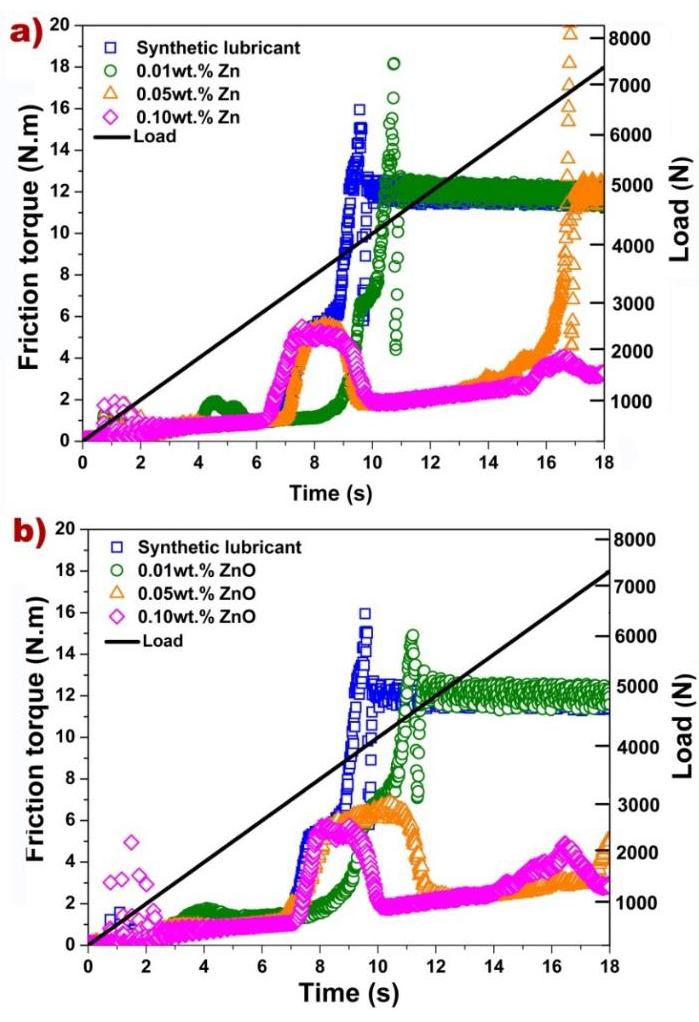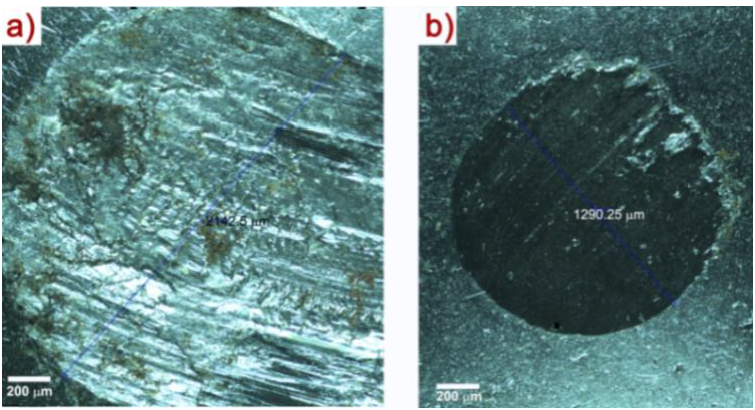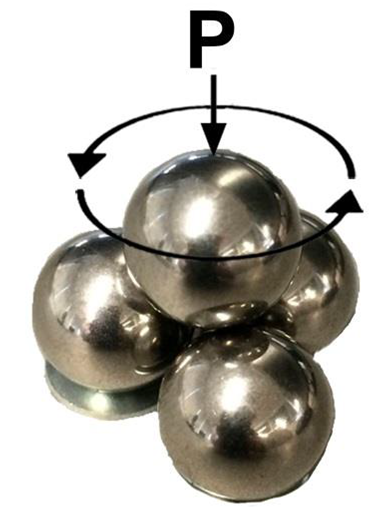1. Introduction
Metal-mechanic industry deals daily with issues concerning tooling and components in constant contact, friction and wear and the effects of high temperatures and loading pressures; particularly in deep-drawing processes (Vallavi, Subramanian, Das, & Nachimuthu, 2017). Metal-forming fluids provide reduction in friction and wear among components under extreme pressure (EP) conditions, as well as serving as cooling media. (Canter, 2009) With aid of proper lubrication and components design, manufacturing processes have been improved under extreme working conditions.
Lubricant properties and materials performance have been widely studied, and nowadays through Nano-technology, next generation greases and lubricants have been able to excel the required working conditions; reducing friction and wear. (Chou & Lee, 2010; Dai, Kheireddin, Gao, & Liang, 2016; Demas, Timofeeva, Routbort, & Fenske, 2012; Ettefaghi, Ahmadi, Rashidi, Mohtasebi, &· Alaei, 2013; Hernandez Battez et al., 2008; Peña-Parás et al., 2015; Laura Peña-Parás et al., 2014; Ran, Yu, & Zou, 2016; Sayuti, Sarhan, & Salem, 2014; Younes, Christensen, Groven, Hong, & Smith, 2016; Zhang, Simionesie, & Schaschke, 2014).
Several types of nanoparticle additives such as nitrides, oxides, and sulfides have shown to improve the load-carrying capacity of conventional metal-forming lubricants. (Alves, Barros, Trajano, Ribeiro, &· Moura. 2013; Choi & Jung, 2012; Laura Peña-Parás et al., 2016: Laura Peña-Parás, Taha-Tijerina, Maldonado-Cortés, et al., 2017; Laura Peña-Parás, Taha-Tijerina, García-Pineda, Maldonado-Cortés, & · Garza, 2017; Thakre & Thakur, 2015) Nanolubricants are prepared by homo geneously dispersing nanoparticles within conventional lu bricants. A mechanism commonly present in nanolubricants states that nanoparticles penetrate in the contact areas, and are deposited on surfaces due their small or similar size as the surface roughness. (Mishina et al., 1993; Taha-Tijerina et al., 2013; Jaime Taha-Tijerina, Laura Peña-Parás, Maldonado, & Cortés, 2016) According to this, friction and wear behavior exhibit different tendencies depending on the nanoparticle used, based in 3 aspects: 1) morphology: nanoparticle shape that allows free movement among gaps in the oil film.; 2) size: larger nanoparticle sizes limit their movements and their ability to be paced in the gaps of the lubricant film; 3) hardness: harder material suffer lower wear and friction.
In recent years, tribology has evolved and with the nanomaterials and additives incursion, novel and more efficient nanolubricant fluids have been developed. Many researchers have investigated the relationship among lubricants and nanoparticles, and it has been established that this interactions could represent the difference between conventional fluids and nanofluids with improved tribological performance. (Choi & Jung, 2012; Gao et al.. 2012; Peña-Parás et al., 2015; Laura Peña-Parás et al.. 2014; Taha-Tijerina et al., 2013). These nanolubricants possess superb characteristics, such as improvements on thermal dissipation, anti-wear and friction reduction properties and EP performance. (Angayarkanni & Philip. 2015; Choi, 2009; Dharmalingam, Sivagnanaprabhu. Senthil Kumar, & Thirumalai, 2014; Jiang et al., 2015; Sharma, Tiwari, & Dixit, 2016; Sun, Zhou, Zhang, & Dang, 2004; Taha-tijerina, Narayanan, Avail, &· Ajayan, 2012; Jaime Taha-Tijerina, Sakhavand, Kochandra, Ajayan Pulickel, & Shahsavari, 2017; Tang & Li, 2014), In recent years, the application of nanolubricants in tribological applications has received significative attention to reduce friction and wear, (Hernandez Battez et al., 2006: Hernández Battez et al., 2008, 2010, Laura Peña-Parás et al., 2014, 2016; Taha-Tijerina et al., 2013) also preventing temperature rise during loading and reduction of shear stress; (Chou & Lee, 2008) which mainly depends upon the size, (Beck, Yuan, Warrier, & Teja, 2009; Chopkar. Das, & Manna, 2006; Gu, Li, Gu, & Zhu, 2008; Kim, ChoL & Kim, 2007; Lou, Zhang, & Wang, 2015) and shape of nanoparticles, (Elias et al., 2013; Kalin, Kogovšek, & Remškar, 2012; Nesappan, Palanisamy, &· Chandran. 2014; Qi, Jia, Yang, & Fan, 2011; Wan, Jin, sun, & Ding, 2015; Zeinali Heris, Razbani, Estelle, & Mahian, 2014) viscosity, (Chou & Lee, 2008; Elias et al., 2013; Gulzar et al., 2016; Havet, Blouet, Robbe Valloire, Brasseur, & Słomka, 2001; Lee et al., 2009; McCants, Ali, & Khan, 2009; Nabeel Rashin & Hemalatha, 2013; Syam Sundar, Singh, & Sousa, 2013; Taha-Tijerina et al., 2014; Jaime Taha-Tijerina et al., 2012; Wan et al., 2015; Zeinali Heris et al., 2014) filler fraction, (Peña-Parás et al., 2015; Laura Peña-Parás et al., 2014, 2015, 2016; Ran et al., 2016) temperature, additives or surfactants usage, (Gara & Zou, 2013; Hernandez Battez et al., 2006; Hernández Battez et al., 2008; Wu et al., 2016) and the defects on the rubbing surfaces. (Antusch et al., 2010; Luo, Wei, Zhao, Cai, & Zheng, 2014; Peng, Kang, Chen, Shu, & Chang, 2010).
For instance, in order to minimize wear, Caixiang et al. dispersed nanoparticles within lubricating oil and observed they deposited at the rubbing surfaces, which were "welded" and reacted to form a tribo-sintered layer. (Gu et al., 2008) It has been also found that nanoparticles suspension increases the load-carrying capacity and decreases the coefficient of friction of the lubricating oil, (Hu, Dong, Chen, & He, 2000; Hu et al., 2002) reducing the contact pressure on the rubbing surfaces. (Padgurskas. Rukuiza, Prosyčevas, &· Kreivaitis, 2013). Also, Chinas-Castillo et al. investigated the phenomenon of nanoparticles behavior within lubricating oils. In their study, it was reported that dispersed nanoparticles can penetrate and strengthen the rubbing contacts by mechanical entrapment. (Chiñas-Castillo & Spikes, 2003). Furthermore, it has been found that the scuffing resistance and frictional power of lubricating oil is enhanced when it is dispersed with 3.0vol.% of nanodiamond structures. (Chu, Hsu, & Lin, 2010).
Nanoparticles based on oxides have shown significant improvements in the tribological properties of nanolubricants. For instance, CuO nanoparticles (<50nm) added (at 0.01wt.%) to a metal-cutting lubricant fluid demonstrated a reduction on the wear scar diameter (WSD) and the coefficient of friction (COF) by 86% and 7%, respectively, in comparison to the base fluid. ( Laura Peña-Parás et al., 2014) Similarly, Alves, et al. (Alves, Mello, Faria, & Camargo, 2016) studied CuO nanoparticles as EP additives in a PAO oil, obtaining reductions in friction and wear properties under boundary conditions.
Hernandez-Battez et al. studied ZnO nanoparticles (20nm) dispersed within poly-alpha-olefin (PA06) lubricant using a four-ball tribotester. The effect of ZnO nanostructures was not significant as an anti-wear agent under certain conditions, however, in EP conditions from the initial seizure load, a decrease in wear was achieved., due to reduction in metal-metal contact (Hernandez Battez et al., 2006) Ran et al. worked on 60SN oil reinforced with ZnO nanoparticles (10 ֊ 30nm), it was found that nanolubricants at 0.2wt.% of ZnO with addition of 10wt.% oleic acid (OA) achieved the best friction-reducing and anti-wear properties; mainly due to the contribution of the nanoparticles acting as nanosized bearings. ( Ran, Yu, Wang, & Xiao, 2015) On investigations performed by Gara et al., (Gara & Zou. 2013) it was demonstrated that oil-based nanolubricants reinforced with ZnO nanoparticles also reduced friction and wear.
In this work, Zn and ZnO nanoparticles (< 50nm) were homogeneously dispersed within a conventional metal-forming synthetic fluid at various filler fractions (0.01, 0.05 and 0.10wt.%). Tribological investigations were performed with a four-ball tribotester, based on the Polish method for testing lubricants under scuffing conditions, developed by the Institute for Sustainable Technologies - National Research Institute (ITEePib). It has been de monstrated that this method is very sensitive to the type and concentration of EP additives. (Szczerek & Tuszyński, 2002) The main benefits of this method are the cost-time relation, due to the test duration (18 seconds) more ex periments are performed in less time, allowing us to reduce the standard deviation. ( Laura Peña-Parás et al., 2014).
2. Materials and methods
2.1 Materials
The studied nanoparticles were Zn and ZnO (See Table 1), supplied by Sigma-Aldrich. The investigated lubricant is a metal-forming synthetic lubricant fluid (See Table 1), which is a medium viscosity fluid used in metal-forming applications such as stamping, drawing and punching operations; providing a light but effective film to reduce wear in tools. Other advantages are the excellent heat transfer, it reduces fractures and it's completely biodegradable. ( Laura Peña-Parás et al., 2014; Ran et al.. 2015).
Table 1 Material Characteristics
| Materials | Properties | |
|---|---|---|
| Base fluid | Density (15°C) | Kinetic Viscosity (mm2/s) |
| Synthetic lubricant | 1.03 g/cm3 | 2.02 @25°c |
| Water ratio (1: 6) | 0.86 @80°c | |
| Nanoparticles | Morphology | Hardness |
| Zn | Spherical (< 50nm) | 2.5 Mohs |
| ZnO | Spherical (~ 30nm) | 4.5 Mohs |
| Test Balls | Chemical Composition | |
| AISI 52100 | 0.98–1.1%C, 0.15–0.30%Si, 0.25–0.45%Mn, 1.30–1.60%Cr, 0.025% P, 0.025% S Diameter: 12.7mm, 60 HRC | |
2.2 Nanolubricants preparation
Zn and ZnO nanoparticles (described in Table 1) were homogeneously dispersed within synthetic lubricant at different concentrations: 0.01, 0.05 and 0.10wt.% for each material. Extended water bath sonication (~3֊4 h) was first used; the water bath was maintained at room temperature (25 °C) to avoid possible nanoparticles agglomeration. Subsequently, a Metason 120T bath sonicator (output power of 70W) was used, according to a previous study by our group. ( Jaime Taha-Tijerina et al.. 2012).
2.3 Tribological evaluation
Tribological properties of base oil and the nanofluids at various filler fractions were measured using a four-ball tribotester. Using this tribotester, the ITEePib Polish method for testing lubricants under scuffing conditions (Michalczewski, Piekoszewski, Tuszyński, Szczerek, & Wulczynski, 2011) can be used to determine the friction torque, the maximum applied load, and the temperature of the lubricants; the limiting pressure of seizure (p oz ) was also evaluated. These evaluations help to identify the EP properties of NFs, namely the time and load when the wear and the loss of film lubricant occur.
The conditions of this test are as follows: an upper ball rotates (See Figure 1) in a perpendicular axis with a speed of 500 rpm against three stationary balls covered with -10mL of lubricant, with a linearly increasing load of 0-7200 N at room temperature (25 ๐C), over the course of 18 s. The load increases until seizure occurs and the lubricant film is destroyed (at 10 N.m), this load is denoted as p oz . If a torque of 10 N.m is not reached and no seizure occurs 7200 N is taken as Poz. For every test, the limiting pressure of seizure, Ροζ, is calculated with the following equation (Eq. 1) (Michalczewski et al., 2011):
The WSD is calculated by averaging the wear scar from the three stationary lower-balls, with minimum of 5 tests for each nanofluid, and following the Dixon probabilistic methodology (Dean & Dixon, 1951; Rorabacher, 1991) to generate statistical reliable results. In general, the addition of nanoparticles resulted in a significant decrease on these parameters. (Taha-Tijerina et al., 2013) Furthermore, the greater the Poz is, the best tribological characteristics the lubricant has.
2.4 Worn surface analysis
Surface roughness of wear scars of steel balls were characterized with an Alicona IF-EdgeMaster optical 3D surface measurement system. Energy Dispersive Spectroscopy (EDS) analysis was performed with a JEOL Scanning Electron Microscope (SEM) using 15kV and 10mm working distance. Three specimens were analyzed, finding a variation of 1 ֊ 2% among them, reporting the most representative value.
3. Results and discussion
Figure 2 shows the friction torque at increasing load over time for Zn and ZnO nanolubricants. It can be observed that the unfilled synthetic lubricant presents seizure before the end of the run, at -3800N. The addition of both nanoparticles delayed seizure at 0.01wt, with loads of -4500N and -4800N for Zn and ZnO nanoparticles, respectively. Higher concentrations showed no lubricant seizure, thus a Pt of 7200N is taken, with the best performance provided by ZnO. This is due to the nanoparticle 'S higher hardness (4.5 Mohs) compared to Zn (2.5 Mohs) that allows for a higher load-carrying capacity. Pressure loss limit was then calculated considering the WSDs of the three lower balls of each test (Figure 3). A comparison between WSDs is shown for pure lubricant and 0.10wt.% ZnO nanolubricants (see Figure 4).

Fig. 2 Friction torque curves at increasing load over time for a) Zn nanolubricants, and b) ZnO nanolubricants.

Fig. 4 Images obtained with ALICONA optical 3D surface of a) Pure synthetic fluid and b) 0.10wt.% ZnO-nanofluid, adhesive wear could be observed, which is evidence of low Рог value.
It is also observed that during the homogeneous dispersion process, a thin tribofilm of ZnO was formed within the fluid and components surfaces. The tribofilm between rubbing surfaces increase the load-carrying capacity of the lubricant:-This effect has been also observed by other authors. (Alves et al., 2016; Chen, Liu, Liu, Gunsel, & Luo, 2015; Peng, Chen, Kang, Chang, & Chang, 2010; Laura Peña-Parás et al., 2014) Chen et al. observed an enhancement on the non-seizure load of liquid paraffin due to the formation of a tribofilm (ultrathin MoS2 nanoparticles). (Chen et al., 2015) Similarly, ՏiՕ2 nanoparticles dispersed in liquid paraffin formed a tribofilm between rubbing surfaces increasing the load-carrying capacity of the lubricant. (Peng, Chen, et al.. 2010).
Roughness was also measured from the average diameter of the three stationary lower-balls, with an Alicona IF-EdgeMaster optical 3D surface measurement system. Table 2 shows the R a : average roughness (pm). R q : root-mean-square roughness (pm), and R z : maximum different roughness (pm). Here, the initial roughness for the steel balls is 0.280 (m).
Table 2 Roughness measured from the WSD
| Sample | Average roughness, Ra (μm) | Root-mean square roughness, Rq (μm) | Maximum different roughness (μm) |
|---|---|---|---|
| Steel ball (Before test) | 0.28 | 0.44 | 1.98 |
| Synthetic base fluid | 3.42 | 4.73 | 13.48 |
| 0.01wt.%Zn nanofluid | 2.32 | 3.28 | 11.94 |
| 0.05wt.%Zn nanofluid | 2.01 | 2.68 | 11.23 |
| 0.10wt.%Zn nanofluid | 2.17 | 2.93 | 12.03 |
| 0.01wt.%ZnO nanofluid | 2.48 | 3.47 | 14.67 |
| 0.05wt.%ZnO nanofluid | 2.18 | 2.99 | 11.29 |
| 0.10wt.%ZnO nanofluid | 1.21 | 1.67 | 6.92 |
In our results high Ra, Rq, and Rz values are obtained for the worn surfaces due to the EPs of the test; a decrease in these values mean lower metal-metal contact due to the presence of the nanoparticle additives. The worn surface with the synthetic base fluid showed Ra of 3.42μm. The nanolubricant containing 0.05wt.% of Zn nanoparticles showed a decrease of 41%, compared to the synthetic fluid. Moreover, the nanolubricant with 0.10wt.% ZnO had the highest decrease in Ra of 65% due to a tribofilm formation, reducing the contact area between moving surfaces.
Figure 5 shows the EDS analysis of steel balls after tribological evaluation. The EDS spectrum and SEM image of a steel ball is presented in Figure 5a as a reference. EDS spectra in Figure 5b and Figure 5c reveal the presence of Zn on the worn surfaces tested with Zn and ZnO nanolubricants. Nanoparticle tribosinterization is also evident in the SEM insets for Figure 5b and Figure 5c, which formed a tribofilm. This tribofilm that prevented metal-metal contact between rubbing surfaces explains the increase in tribological and surface roughness properties shown in Figure 2, Figure 3, and Table 2. Additionally, the presence of residual elements like potassium (K) and calcium (Ca) are expected since potassium salicylate and calcium chloride are used as additives within conventional metal-mechanic lubricants (Brinksmeier, Meyer. Huesmann-Cordes, & Herrmann, 2015), US8299007 B2, 2010.
4. Conclusions
After an evaluation of various concentrations of Zn and ZnO nanoparticles homogeneously dispersed within a conventional synthetic fluid, it can be concluded that these additives provide significant enhancements on EP properties. The highest improvement was shown by the 0.10wt.% ZnO nanofluid, preventing lubricant seizure and with a superb impact in p oz of up to 250%. It is also worth noting that all the other concentrations of nanoparticles increased tribological properties. These small nanostructures were tribosintered onto the surfaces forming a tribofilm, reducing the contact area, surface roughness, and wear of materials, and potentially be employed as EP lubricant additives for metal-forming processes.











 nueva página del texto (beta)
nueva página del texto (beta)





